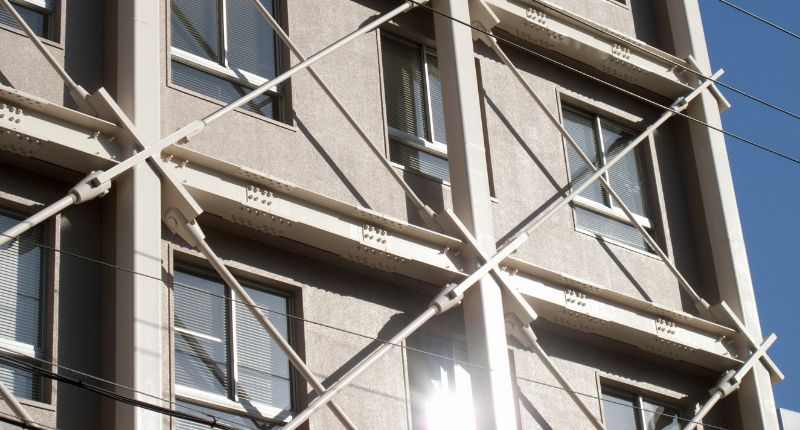- Urban retrofitting may be pivotal in achieving 2030 emission reduction target.
- Retrofitting offers substantial economic savings and reduced emissions.
- Converting obsolete offices into homes can also deliver urgently needed housing.
Another year has passed, and with that, Australia’s impending deadline to reach its 2030 emissions target, a reduction of 43% compared to 2005’s levels, moves closer.
Recently, the Climate Change Authority warned the Labour Government that it was not on track to meet its goal by the decade’s end.
According to the organisation, the Government’s plan to reach its 2030 target relied heavily on transitioning the nation’s energy capacity to reach an 82% renewables target, one of which it was falling short.
With the deadline looming, additional approaches that can facilitate decarbonisation are worth exploring.
Accordingly, a new paper written by the University of Melbourne (UoM) researchers Professor Sarah Bell, Dr Judy Bush, and Enzo Lara-Hamilton asserts that urban retrofitting has the potential to be the lynchpin of Australia’s emission reduction strategy.
What is retrofitting
Retrofitting happens when we upgrade our pre-existing physical systems to improve their operation. Several retrofitting methods exist, including refurbishment, renovation, adaptive reuse, repair, and restoration.
They can happen at many scales and within many sectors, from simple changes like energy-efficient light upgrades in suburban homes to larger projects like precinct-wide water system improvements.
Cities can lower their embodied and operational emission, resource use, and waste by improving or recycling our existing infrastructure rather than building something new.
The benefits of retrofitting our buildings
The office sector has been floundering through the last 12 months. A recent Ray White report indicates that offices are the nation’s worst-performing sector, posting declines in capital value of 9% over the year to September 2023.
Offices the worst performing asset

A number of factors underlie this trend. First, the global COVID-19 pandemic and its subsequent lockdowns have taught employees and corporations that good work can be done remotely. Furthermore, while Australians are returning to the office, hybrid working is increasingly becoming the norm.
Demand for offices is now concentrated in the prime office sector, with companies prizing offices with top-notch amenities in highly desirable lifestyle locations.
Consequently, multi-speed conditions have emerged nationwide, and vacancies within the secondary market have skyrocketed.
Along with the amenities and location of offices, sustainability is at the forefront of prime office demand. Recognising their climate obligations, sustainability is part of most companies’ agenda, and employees expect their workplaces to impact the environment positively.
With Australia’s older offices accumulating dust and investors and tenants demanding ‘green buildings’, there is substantial opportunity in ‘re-lifing’ Australia’s old office stock, turning neglected old offices into attractive, top-grade, sustainable ones
Doing so can save the nation a lot of money and drastically reduce greenhouse gas emissions. According to the UoM report, retrofits can save up to $17 billion and 171 million tonnes (mt) of greenhouse gas emissions over 15 years.
Additionally, The Australian Sustainable Built Environment Council (ASBEC) estimates that the nation’s building sector has the potential to achieve up to 28% of Australia’s 2030 emission reduction target.
In short, by retrofitting the nation’s buildings, we make significant headway on our emission targets.
Enhancing our homes
Sustainability is also a top priority for home buyers and renters. Energy-efficient homes can help Australians save money, which may be in short supply as the country wrestles with a cost-of-living crisis.
In addition, they provide a host of health benefits. For instance, switching from gas to electrical-powered appliances can lower one’s risk of carbon monoxide poisoning.
“Retrofitting housing is important to improve the energy efficiency and comfort of existing homes. This can help reduce energy bills and improve people’s health. Retrofitting rental properties is especially important to improve the health and comfort of tenants and reduce their energy bills,” said City of Melbourne chair in Urban Resilience and Innovation and report author, Professor Sarah Bell.
Turning buildings into housing
Another innovative way of addressing obsolescent buildings is by converting Australia’s neglected offices into residential apartments. This can also tackle the separate and equally prevalent housing challenges that Australia is plagued with at present.
National total property listings
One example is The Alba, an adaptive reuse project involving Australian Unity turning their abandoned, ageing corporate headquarters into a luxury care residence.

“Retrofitting can also play a role in increasing housing supply. Conversion of commercial buildings into housing has the potential to create new, affordable homes in business districts that are under-utilised as people work from home,” Bell said.
“Australian Unity’s The Alba is a beautiful example of how our cities can adapt to the changing needs of the community. It provides a new lifestyle option for older people, utilising an existing building for a new purpose.
“The Make Room project by the City of Melbourne is an initiative that is adapting buildings to meet community needs. A Council-owned building in Melbourne’s CBD is being converted into supported housing for people currently experiencing homelessness.”








